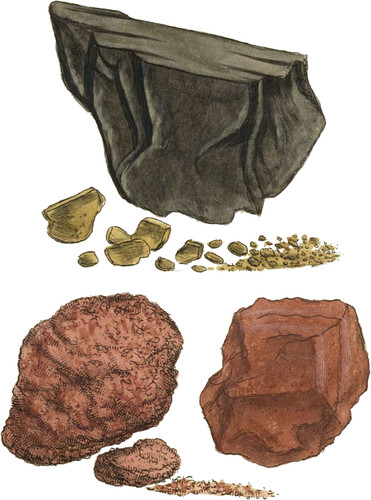 Enlarge
Enlarge
British Mineralogy
The Alluvial Depositions forming Soils
- Class 2. Earths.
- Order 3. Mixed.
The surface of the Earth, alluvial or vegetating Débris, so admirably contrived by the laws of Nature for our agricultural use, have scarcely been attended to by Mineralogists, and in general make so small a part in their works, that they would seem to be of little consequence; and the importance of a more accurate knowledge, and the very use of them in vegetation, has even been superseded by many chimerical ideas. Nature kindly allows, and even invites us, to show industry and sagacity in many instances, but we must be heedful not to mistake her contrivances.
The top figure is a representation of a very fissile rock of a nature scarcely noticed: it is a variety of clayey Shale, containing a small portion of Iron and Bitumen: it crackles in the fire, and when red-hot produces a little flame. The outside passes in colour from blackish to a lightish rusty brown; it splits and Falls to pieces in the weather, forming at its foot a. soil very different from the original appearance of the rock—see the representations under it. I had it from Bakewell in Derbyshire, where it is considered as excellent for Firs, Elms, and Fruit Trees. The Bakewell Rotten Stone, tab. 240, is a curiosity in its agricultural character; it is well known to produce white Clover spontaneously the second year after its being formed into meadow. Oaks do not thrive in it: it is a good manure for gravelly soils.
The right hand loner figure represents a part of a red rock from Beau mares in North Wales. It has very much the appearance of a baked tile. The fresh soil formed from this is reckoned very fertile: it forms crumbling lumps—see the left hand figure—chiefly composed of Silex, Clay, and Oxide of Iron.

